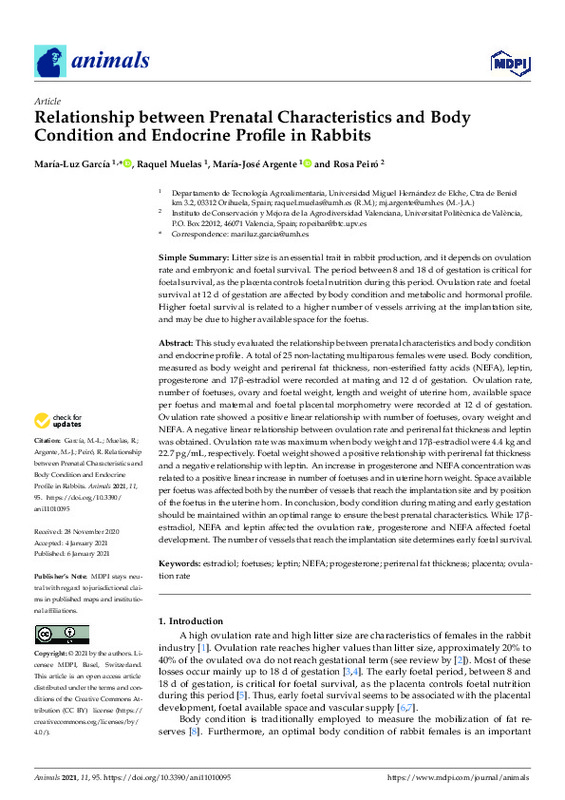JavaScript is disabled for your browser. Some features of this site may not work without it.
Buscar en RiuNet
Listar
Mi cuenta
Estadísticas
Ayuda RiuNet
Admin. UPV
Relationship between Prenatal Characteristics and Body Condition and Endocrine Profile in Rabbits
Mostrar el registro sencillo del ítem
Ficheros en el ítem
| dc.contributor.author | García, María-Luz
|
es_ES |
| dc.contributor.author | Muelas, Raquel
|
es_ES |
| dc.contributor.author | Argente, María-José
|
es_ES |
| dc.contributor.author | Peiró Barber, Rosa Mª
|
es_ES |
| dc.date.accessioned | 2022-05-30T18:05:04Z | |
| dc.date.available | 2022-05-30T18:05:04Z | |
| dc.date.issued | 2021-01 | es_ES |
| dc.identifier.uri | http://hdl.handle.net/10251/182990 | |
| dc.description.abstract | [EN] Litter size is an essential trait in rabbit production, and it depends on ovulation rate and embryonic and foetal survival. The period between 8 and 18 d of gestation is critical for foetal survival, as the placenta controls foetal nutrition during this period. Ovulation rate and foetal survival at 12 d of gestation are affected by body condition and metabolic and hormonal profile. Higher foetal survival is related to a higher number of vessels arriving at the implantation site, and may be due to higher available space for the foetus. This study evaluated the relationship between prenatal characteristics and body condition and endocrine profile. A total of 25 non-lactating multiparous females were used. Body condition, measured as body weight and perirenal fat thickness, non-esterified fatty acids (NEFA), leptin, progesterone and 17 beta-estradiol were recorded at mating and 12 d of gestation. Ovulation rate, number of foetuses, ovary and foetal weight, length and weight of uterine horn, available space per foetus and maternal and foetal placental morphometry were recorded at 12 d of gestation. Ovulation rate showed a positive linear relationship with number of foetuses, ovary weight and NEFA. A negative linear relationship between ovulation rate and perirenal fat thickness and leptin was obtained. Ovulation rate was maximum when body weight and 17 beta-estradiol were 4.4 kg and 22.7 pg/mL, respectively. Foetal weight showed a positive relationship with perirenal fat thickness and a negative relationship with leptin. An increase in progesterone and NEFA concentration was related to a positive linear increase in number of foetuses and in uterine horn weight. Space available per foetus was affected both by the number of vessels that reach the implantation site and by position of the foetus in the uterine horn. In conclusion, body condition during mating and early gestation should be maintained within an optimal range to ensure the best prenatal characteristics. While 17 beta-estradiol, NEFA and leptin affected the ovulation rate, progesterone and NEFA affected foetal development. The number of vessels that reach the implantation site determines early foetal survival. | es_ES |
| dc.description.sponsorship | This research was funded by Generalitat Valenciana, grant number GVPRE/2008/145. | es_ES |
| dc.language | Inglés | es_ES |
| dc.publisher | MDPI AG | es_ES |
| dc.relation.ispartof | Animals | es_ES |
| dc.rights | Reconocimiento (by) | es_ES |
| dc.subject | Estradiol | es_ES |
| dc.subject | Foetuses | es_ES |
| dc.subject | Leptin | es_ES |
| dc.subject | NEFA | es_ES |
| dc.subject | Progesterone | es_ES |
| dc.subject | Perirenal fat thickness | es_ES |
| dc.subject | Placenta | es_ES |
| dc.subject | Ovulation rate | es_ES |
| dc.subject.classification | GENETICA | es_ES |
| dc.title | Relationship between Prenatal Characteristics and Body Condition and Endocrine Profile in Rabbits | es_ES |
| dc.type | Artículo | es_ES |
| dc.identifier.doi | 10.3390/ani11010095 | es_ES |
| dc.relation.projectID | info:eu-repo/grantAgreement/GVA//GVPRE%2F2008%2F145/ | es_ES |
| dc.rights.accessRights | Abierto | es_ES |
| dc.contributor.affiliation | Universitat Politècnica de València. Departamento de Biotecnología - Departament de Biotecnologia | es_ES |
| dc.description.bibliographicCitation | García, M.; Muelas, R.; Argente, M.; Peiró Barber, RM. (2021). Relationship between Prenatal Characteristics and Body Condition and Endocrine Profile in Rabbits. Animals. 11(1):1-13. https://doi.org/10.3390/ani11010095 | es_ES |
| dc.description.accrualMethod | S | es_ES |
| dc.relation.publisherversion | https://doi.org/10.3390/ani11010095 | es_ES |
| dc.description.upvformatpinicio | 1 | es_ES |
| dc.description.upvformatpfin | 13 | es_ES |
| dc.type.version | info:eu-repo/semantics/publishedVersion | es_ES |
| dc.description.volume | 11 | es_ES |
| dc.description.issue | 1 | es_ES |
| dc.identifier.eissn | 2076-2615 | es_ES |
| dc.identifier.pmid | 33419042 | es_ES |
| dc.identifier.pmcid | PMC7825349 | es_ES |
| dc.relation.pasarela | S\447046 | es_ES |
| dc.contributor.funder | Generalitat Valenciana | es_ES |








